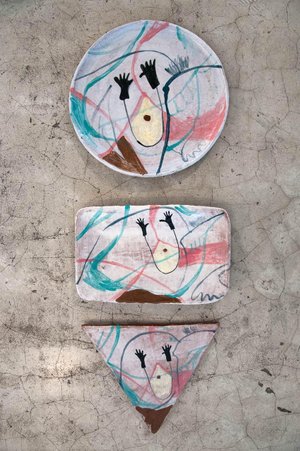
Merike Estna
merike(@)estna.com
represented by:
Temnikova & Kasela
Tallinn, Estnoia
info(@)temnikova.ee
http://temnikova.ee
Karen Huber
Mexico City, Mexico
info(@)karen-huber.com
http://karen-huber.com

In her artistic practice, Merike Estna seeks for the conceptual integration of painting and daily life.
More specifically, Estna looks to expand and inscribe the languages, processes and applications of painting onto carefully thought scenographies and stage-setups, in which exchanges take place between groups
of participants and the often unstable, malleable connotations and formal qualities of painting.
Here one could think of the many events and encounters she conceives, among spa sessions, with painted robes, drinks and juices with painterly connotations, as well as the painted stages for performance and
video works, in which she seeks to reunite the fabric of painting with the fabric of social life—all whilst blurring and making ambiguous the roles of material entities as performers, subjects as objects, and
support structures as assembling grounds.
Estna’s work is thoroughly invested in the processes of painting, in her case employed as a way
of approaching the artwork as an integral part of daily life—painting as life, rather than about crystallising aspects of life. In her process-based work, Estna is embedding patterns and colour combinations derived from the crafts and applied arts, vocabularies which haven’t traditionally been accepted in the visual language and discourse of painting. In so doing, her work is challenging the masculine territory of painting and questioning the strict visual separations and oppositions between the discourses of painting and craft. Initially subjecting canvases to such patterns and application-based treatments, Estna has gradually progressed to cover clothes, objects and entire spaces with cotton wool colours, gradually expanding
her research into colour schemes, gradients, and the acts of painting applications, towards a widening
of the possibilities of experiencing and looking at the painting act more-dimensionally.
Here it could be claimed that Estna is pushing painting into a discomfort zone, posing questions around what is “sincere” abstract art, enhancing this disquiet even further by the use of unconventional materials that are not generally considered “painterly,” such as apparel, food and liquids. Some of her works could be envisioned as a space for wellbeing, or “well-beings” rather, in which painterly dimensions and applications form the unifying element, whilst underscoring acts of collectivity, togetherness, attention, adaptation and energy-exchange. The work is often activated by visitors, whereas the painting element is initially invisible and will gradually unfold: appearing within the books on display, the glasses or drinks served.
Her installations become a meeting point for discussing adaptation and survival modes, in which painterly properties take on liquid shapes within an equally " fluid and networked society.
Niekolaas Johannes Lekkerkerk
https://theofficeforcurating.com
immerses the visitor in an overall sensory-cultural experience. On entering the expanded space
strips of canvas, ventilators, TV screens – all aspire to one single thing: to be paintings.
zone- can such combination be treated as serious abstract art? And who makes the decision?
of perception, Estna makes us question our assumtious about how to look or engage with art objects
and things in general. The conventional rules of those encounters are reversed: While paintings gain

